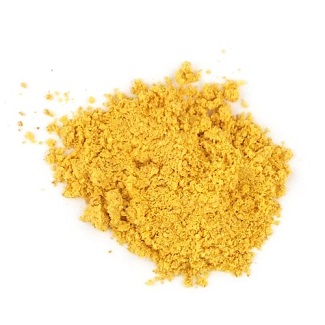Strontiumchromat Chemische Eigenschaften,Einsatz,Produktion Methoden
ERSCHEINUNGSBILD
GELBES KRISTALLINES PULVER.
CHEMISCHE GEFAHREN
Starkes Oxidationsmittel. Reagiert mit brennbaren und reduzierenden Stoffen.
ARBEITSPLATZGRENZWERTE
TLV:(als Cr) 0.0005 mg/m?(als TWA); Krebskategorie: A1; (ACGIH 2005).
MAK: Sensibilisierung der Haut; Krebserzeugend Kategorie 2; (DFG 2005).
AUFNAHMEWEGE
Aufnahme in den K?rper durch Inhalation des Aerosols und durch Verschlucken.
INHALATIONSGEFAHREN
Eine gesundheitssch?dliche Partikelkonzentration in der Luft kann beim Dispergieren schnell erreicht werden.
WIRKUNGEN BEI KURZZEITEXPOSITION
WIRKUNGEN BEI KURZZEITEXPOSITION: Die Substanz reizt die Augen, die Haut und die Atemwege.
WIRKUNGEN NACH WIEDERHOLTER ODER LANGZEITEXPOSITION
Wiederholter oder andauernder Hautkontakt kann zu Hautsensibilisierung führen. Wiederholte oder andauernde Inhalation kann asthmatische Beschwerden hervorrufen. M?glich sind Auswirkungen auf Atmungsorganeund Nieren. Führt zu Perforation der Nasenscheidewand und Nierensch?den. Krebserzeugend für den Menschen.
LECKAGE
Verschüttetes Material in Beh?ltern sammeln; falls erforderlich durch Anfeuchten Staubentwicklung verhindern. Reste sorgf?ltig sammeln. An sicheren Ort bringen. NICHT in die Umwelt gelangen lassen. Chemikalienschutzanzug mit umgebungsluftunabh?ngigem Atemschutzger?t.
R-S?tze Betriebsanweisung:
R45:Kann Krebs erzeugen.
R22:Gesundheitssch?dlich beim Verschlucken.
R50/53:Sehr giftig für Wasserorganismen, kann in Gew?ssern l?ngerfristig sch?dliche Wirkungen haben.
S-S?tze Betriebsanweisung:
S53:Exposition vermeiden - vor Gebrauch besondere Anweisungen einholen.
S45:Bei Unfall oder Unwohlsein sofort Arzt zuziehen (wenn m?glich, dieses Etikett vorzeigen).
S60:Dieses Produkt und sein Beh?lter sind als gef?hrlicher Abfall zu entsorgen.
S61:Freisetzung in die Umwelt vermeiden. Besondere Anweisungen einholen/Sicherheitsdatenblatt zu Rate ziehen.
Chemische Eigenschaften
Strontium chromate a light yellow crystalline solid or powder.

Strontium chromate is prepared by precipitating a suitably soluble chromate with an appropriate strontium salt. Finding a primary use in corrosion-inhibiting coatings, this pigment has poor tint strength, low opacity, and unsatisfactory alkali and acid resistance, which limits its more widespread use in the coatings industry. Little of this pigment is now manu- factured in the United States.
Verwenden
Strontium chromate is mainly used to prevent corrosion on aluminum, and primers containing this pigment are standard for the aviation industry. Strontium chromate is so effective at low loadings that it is often used to provide inhibition for coil coatings despite the fact that it is the most expensive chromate inhibitor. The pigment is sometimes combined with zinc chromate in water-based formulations. In these cases, to avoid stability problems, loadings are kept at low levels, about 2% total chromate.
Corrosion inhibitor in pigments; in electrochemical processes to control sulfate concentration of solutions.
Allgemeine Beschreibung
STRONTIUM CHROMATE is a light yellow powder or granular solid. STRONTIUM CHROMATE is insoluble in water. The primary hazard is the threat to the environment. Immediate steps should be taken to limit its spread to the environment. STRONTIUM CHROMATE is used as a pigment, a protective coating against corrosion, and in pyrotechnics.
Air & Water Reaktionen
STRONTIUM CHROMATE is insoluble in water. Reactivity in Water: Produces hazardous solution.
Reaktivit?t anzeigen
Oxidizing agents, such as STRONTIUM CHROMATE, can react with reducing agents to generate heat and products that may be gaseous (causing pressurization of closed containers). The products may themselves be capable of further reactions (such as combustion in the air). The chemical reduction of materials in this group can be rapid or even explosive, but often requires initiation (heat, spark, catalyst, addition of a solvent). Explosive mixtures of inorganic oxidizing agents with reducing agents often persist unchanged for long periods if initiation is prevented. Such systems are typically mixtures of solids, but may involve any combination of physical states. Some inorganic oxidizing agents are salts of metals that are soluble in water; dissolution dilutes but does not nullify the oxidizing power of such materials. Organic compounds, in general, have some reducing power and can in principle react with compounds in this class. Actual reactivity varies greatly with the identity of the organic compound. Inorganic oxidizing agents can react violently with active metals, cyanides, esters, and thiocyanates. Avoid contact with water, acids, and bases.
Hazard
Toxic by ingestion. Confirmed carcinogen.
Health Hazard
INHALATION: Irritating to mucous membranes. SKIN: Repeated skin contact can cause eczematous dermatitis, with edema and ulceration. INGESTION: Dizziness, intense thirst, abdominal pain, vomiting, shock and oliguria or anuria.
Brandgefahr
Behavior in Fire: Heat stable
Sicherheitsprofil
Confirmed human carcinogen with experimental carcinogenic and tumorigenic data. Moderately toxic by ingestion. Mutation data reported. See also CHROMIUM COMPOUNDS and STRONTIUM COMPOUNDS.
m?gliche Exposition
Strontium chromate is used as a metal protective coating to prevent corrosion, in wash primers; and aluminum flake coatings; colorant in polyvinyl chloride resins and pyrotechnics.
Versand/Shipping
UN3086 Toxic solids, oxidizing, n.o.s., Hazard Class: 6.1; Labels: 6.1-Poisonous materials, 5.1-Oxidizer. Technical Name Required.
l?uterung methode
Crystallise strontium chromate from water (40mL/g) by cooling.
Inkompatibilit?ten
Violent reaction with strong oxidizers, hydrazine. Incompatible with combustible, organic, or other readily oxidizable materials, such as paper, wood, sulfur, aluminum powder. Attacks plastics and coatings
Strontiumchromat Upstream-Materialien And Downstream Produkte
Upstream-Materialien
Downstream Produkte

